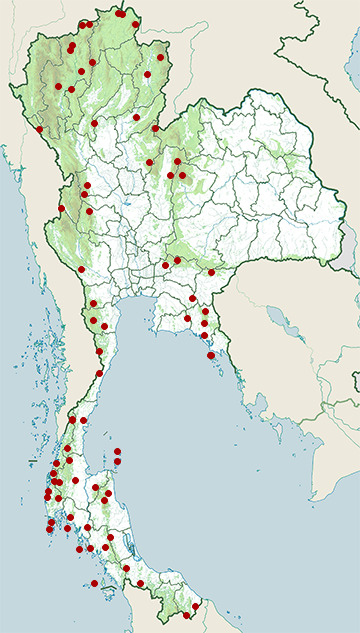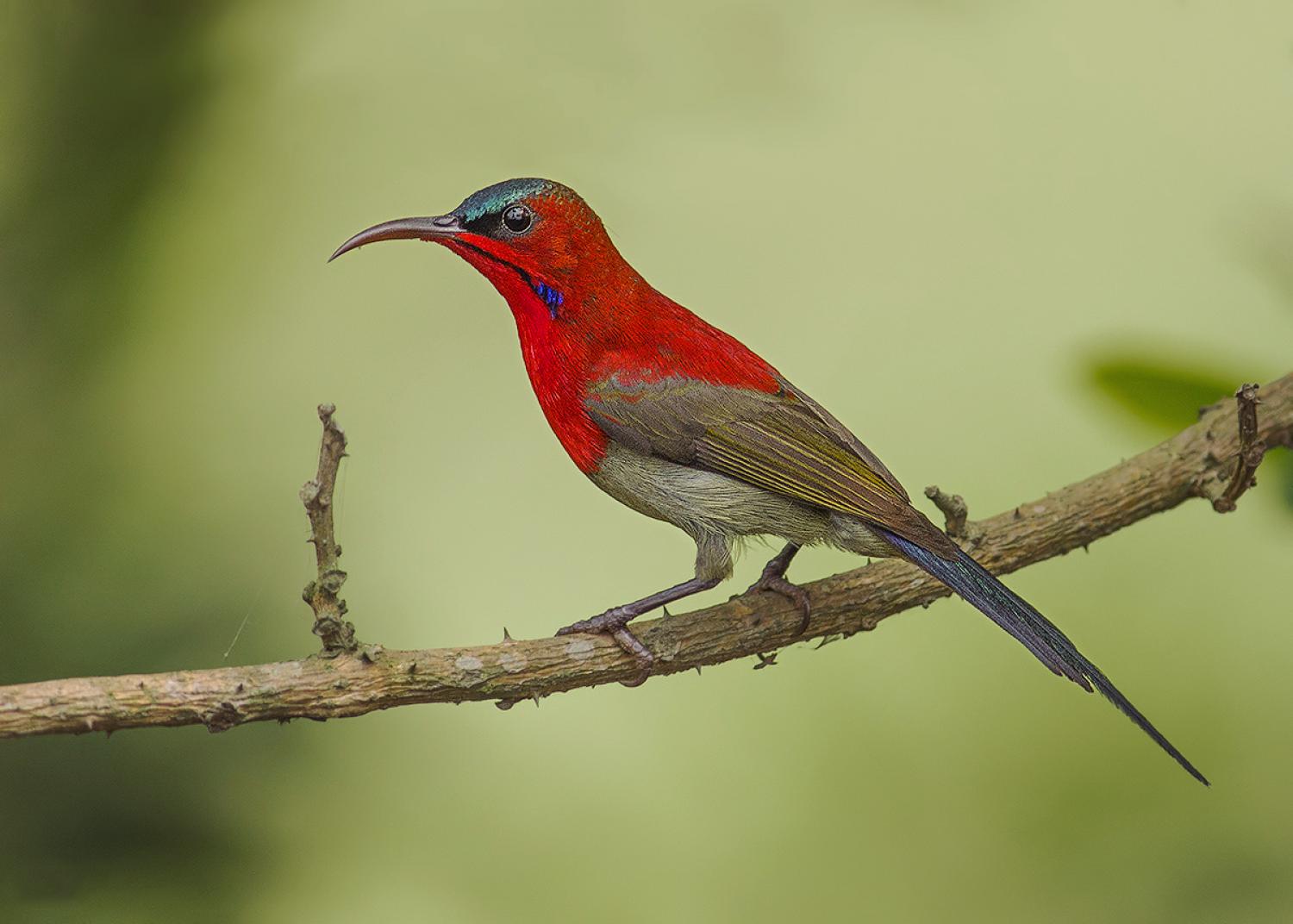Species of Thailand
Crimson sunbird
Aethopyga siparaja
Thomas Stamford Raffles, 1822
In Thai: นกกินปลีคอแดง
The crimson sunbird (Aethopyga siparaja) is a species of bird in the sunbird family which feed largely on nectar, although they will also take insects, especially when feeding the young. Flight is fast and direct on their short wings. Most species can take nectar by hovering like a hummingbird, but usually perch to feed most of the time.
They are also the unofficial national bird of Singapore
Description
Crimson sunbirds are tiny, only 11 cm long. They have medium-length thin down-curved bills and brush-tipped tubular tongues, both adaptations to their nectar feeding. The adult male has a crimson breast and maroon back. The rump is yellow and the belly is olive. The female has an olive-green back, yellowish breast and white tips to the outer tail feathers. In most of the range, males have a long green-blue tail, but A.s. nicobarica of the Nicobar Islands and the former subspecies A. vigorsii (Western crimson sunbird) of the Western Ghats of India lack the long central tail feathers. Their call is chee-cheewee.
Distribution and habitats
The crimson sunbird is a resident breeder in tropical southern Asia from India, through Nepal, Bangladesh and Myanmar to Indonesia. Two or three eggs are laid in a suspended nest in a tree. This species occurs in forest and cultivated areas.
This article uses material from Wikipedia released under the Creative Commons Attribution-Share-Alike Licence 3.0. Eventual photos shown in this page may or may not be from Wikipedia, please see the license details for photos in photo by-lines.
Category / Seasonal Status
BCST Category: Recorded in an apparently wild state within the last 50 years
BCST Seasonal status: Resident or presumed resident
Scientific classification
- Kingdom
- Animalia
- Phylum
- Chordata
- Class
- Aves
- Order
- Passeriformes
- Family
- Nectariniidae
- Genus
- Aethopyga
- Species
- Aethopyga siparaja
Common names
- Thai: นกกินปลีคอแดง
Conservation status

Least Concern (IUCN3.1)
Photos
Please help us review the bird photos if wrong ones are used. We can be reached via our contact us page.
Range Map

- Chiang Dao District, Chiang Mai
- Chiang Dao Wildlife Sanctuary
- Chiang Saen District, Chiang Rai
- Doi Inthanon National Park
- Doi Pha Hom Pok National Park
- Doi Phu Kha National Park
- Doi Saket District, Chiang Mai
- Hala-Bala Wildlife Sanctuary
- Hat Chao Mai National Park
- Huai Kha Khaeng Wildlife Sanctuary
- Huai Yang Waterfall National Park
- Kaeng Krachan National Park
- Kaeng Krung National Park
- Khao Ang Rue Nai Wildlife Sanctuary
- Khao Chamao - Khao Wong National Park
- Khao Khitchakut National Park
- Khao Lak - Lam Ru National Park
- Khao Luang National Park
- Khao Nam Khang National Park
- Khao Nan National Park
- Khao Phra - Bang Khram Wildlife Sanctuary
- Khao Phra Thaeo Wildlife Sanctuary
- Khao Pu - Khao Ya National Park
- Khao Soi Dao Wildlife Sanctuary
- Khao Sok National Park
- Khao Yai National Park
- Khiri Rat Nikhom District, Surat Thani
- Khlong Lan National Park
- Khlong Nakha Wildlife Sanctuary
- Khun Chae National Park
- Khura Buri District, Phang Nga
- Ko Chang District, Trat
- Ko Chang National Park
- Ko Lanta National Park
- Ko Samui District, Surat Thani
- Kromluang Chumphon Wildlife Sanctuary
- Kui Buri National Park
- Lam Nam Nan National Park
- Mae Ai District, Chiang Mai
- Mae Moei National Park
- Mae Wong National Park
- Mueang Chumphon District, Chumphon
- Mueang Krabi District, Krabi
- Mueang Nakhon Nayok District, Nakhon Nayok
- Mueang Nan District, Nan
- Mueang Phuket District, Phuket
- Nam Nao National Park
- Namtok Phlio National Park
- Nong Bong Khai Non-Hunting Area
- Pa Sang District, Lamphun
- Pachee River Wildlife Sanctuary
- Pang Sida National Park
- Phato District, Chumphon
- Phi Phi Islands
- Phu Khiao Wildlife Sanctuary
- Phu Suan Sai National Park
- Sai Yok District, Kanchanaburi
- Si Satchanalai National Park
- Sri Phang-nga National Park
- Su-ngai Kolok District, Narathiwat
- Tai Rom Yen National Park
- Takua Pa District, Phang Nga
- Tarutao National Marine Park
- Tat Mok National Park
- Tha Yang District, Phetchaburi
- Than Sadet - Koh Pha-Ngan National Park
- Thung Salaeng Luang National Park
- Thung Yai Naresuan Wildlife Sanctuary
- Ton Nga-Chang Wildlife Sanctuary
- Ton Pariwat Wildlife Sanctuary
- Wang Mai Forest Restoration Project
- Wiang Kaen District, Chiang Rai
- Yan Ta Khao District, Trang


